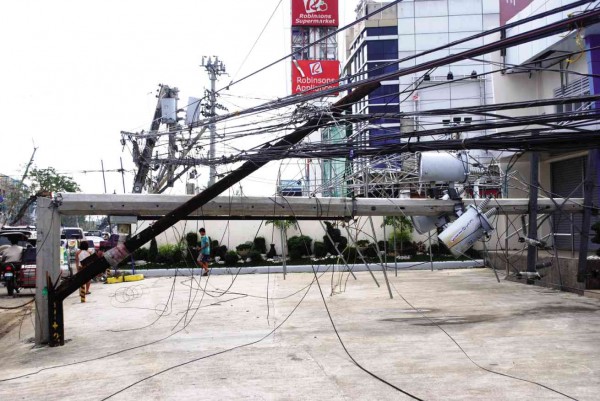
THE DEVASTATION wrought by Typhoon “Santi” in Nueva Ecija province is mirrored by this electric post that strong winds from Santi toppled near a mall in Cabanatuan City. ANSELMO ROQUE/INQUIRER CENTRAL LUZON
CABANATUAN CITY—Whenever a Nueva Ecija rice farmer fails to have a surplus from his harvest, he calls himself “magsasako” to add humor to his predicament.
The word is a play on “magsasaka,” the local term for farmer, being reduced to holding an empty sack (“sako”) because of poor harvest. All he has to bring home are empty sacks after paying his obligations to creditors.
Typhoon “Santi,” which struck Central Luzon last week, reduced thousands of farmers in Nueva Ecija province into prospective magsasako. This was because their soon-to-be harvested rice crops were flattened by strong winds, dousing hopes of a good harvest, farmers said.
Rethink policy
An economist from the government think tank Philippine Institute for Development Studies (PIDS) cited estimated losses of P2.9 billion in rice production alone to press for a rethinking of the government’s rice importation policy.
Roehlano Briones, senior research fellow at PIDS, in a study, projected prices to go higher as a result of the devastation wrought by Santi.
“Even without the devastation, we need a more open policy toward rice importation. The impact of Typhoon Santi makes it even more necessary,” Briones said in his study.
Santi damaged some 134,017 metric tons of rice in three regions.
Central Luzon, considered as one of the country’s rice granaries, suffered the biggest loss at P2.2 billion.
Ecija losses
Gov. Aurelio Umali, in a radio interview on Tuesday, said the province was expecting at least P2.7 billion worth of losses in palay production.
He said it was a big letdown for farmers in Nueva Ecija.
Serafin Santos, provincial agriculturist, said they did an aerial survey of rice crops planted in 165,000 hectares damaged by Santi and estimated that about 60 percent of crops in these farms were ready to be harvested.
“They lodged (stalks are bent and broken), with some of them soaked in water,” Santos said.
He said only about 10 percent of the total 195,000 ha of rice lands used for the current cropping season were harvested before the typhoon hit Nueva Ecija.
He said 56 percent of Nueva Ecija’s rice production was distributed in Central Luzon while 10 percent went to Metro Manila.
Assessments made by the regional field unit of the Department of Agriculture in Central Luzon indicated that at least 108,721 MT of expected palay harvest in Nueva Ecija were lost to the typhoon.
The DA said the volume was about 80 percent of the 133,943 MT of total palay losses in Tarlac and Bulacan.
“It seems that I will only be left with an empty sack when I harvest my palay,” said Manolo Matutino, a farmer of Sta. Rosa town.
Farm dependents
Records from the provincial agriculturist office showed that at least 100,000 families in Nueva Ecija depend on rice farming while more than 280,000 people belong to the agriculture labor force.
Reynato Arimbuyutan, chair of the Nueva Ecija chapter of the Philippine Chamber of Commerce and Industry (PCCI), said the reduced palay harvest in the province would have a big impact on business establishments.
“As we all know, when farmers score a good harvest, they become the big clients of local businesses. Now that their cropping failed, we expect business activities to slacken,” he said.
Higher prices
Edgardo Alfonso, head of a group of 26 rice millers in San Jose City, said the buying price of palay would be higher.
“Rice millers and traders will naturally compete to get the volume of palay needed for their milling operations. They will offer higher purchasing price,” he said.
The current buying price of palay is P13 to P14 a kilogram of fresh harvest and P19 to P20 a kilogram for the clean and dry palay.